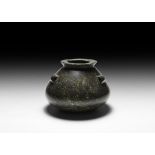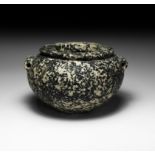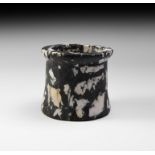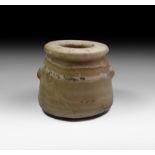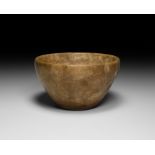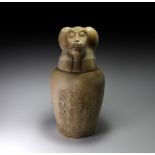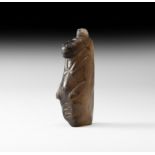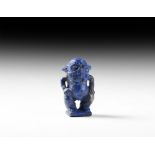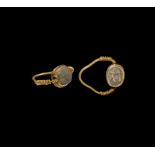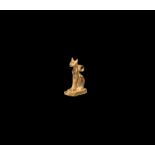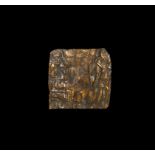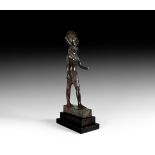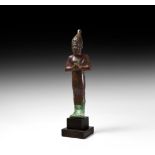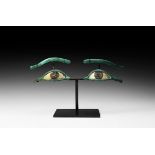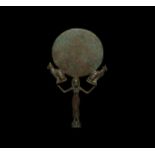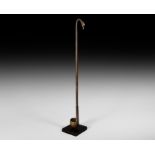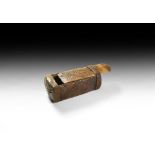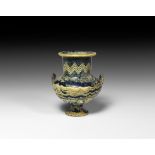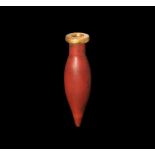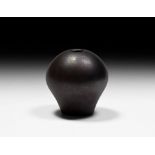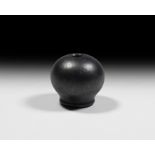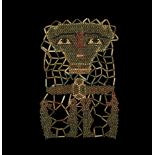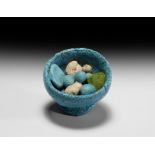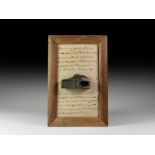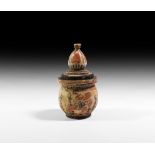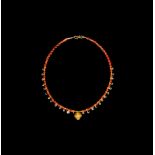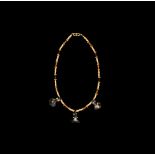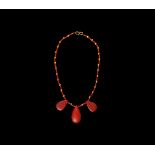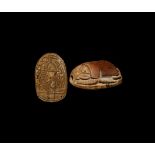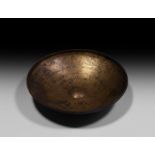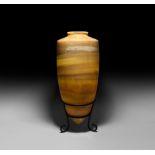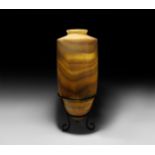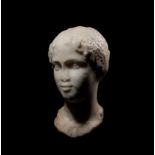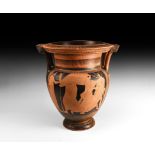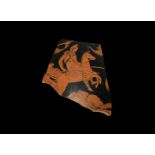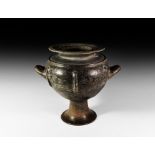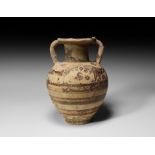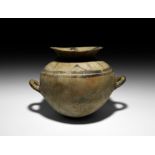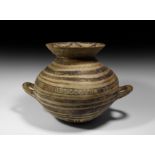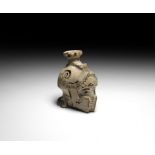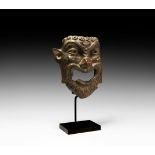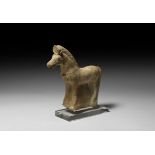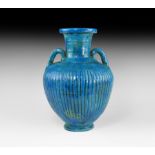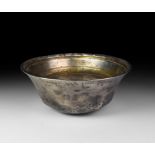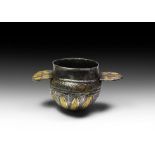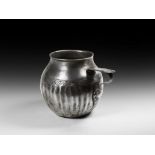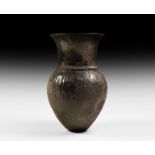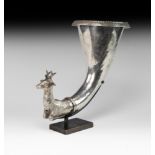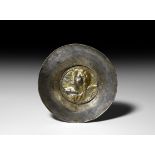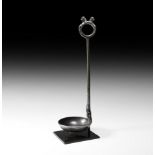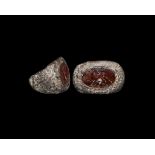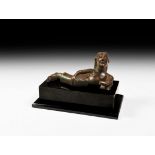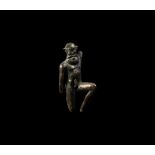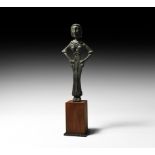Refine your search
Estimate
Category
- Jewellery (143)
- Collectables (92)
- Arms, Armour & Militaria (65)
- Sculpture (61)
- Greek, Roman, Egyptian & Other Antiquities (58)
- Taxidermy & Natural History (22)
- Books & Periodicals (20)
- Ceramics (14)
- Metalware (10)
- Salvage & Architectural Antiques (10)
- Chinese Works of Art (9)
- Coins (8)
- Glassware (8)
- Russian Works of Art (7)
- Ethnographica & Tribal Art (6)
- Islamic Works of Art (4)
- Musical Instruments & Memorabilia (3)
- Scientific Instruments (3)
- Silver & Silver-plated items (3)
- Vintage Fashion (3)
- Carpets & Rugs (2)
- Kitchenalia (2)
- Clocks (1)
- Furniture (1)
- Lighting (1)
- Prints (1)
- Sporting Memorabilia & Equipment (1)
- Stamps (1)
- Textiles (1)
- List
- Grid
A subscription to the Price Guide is required to view results for auctions ten days or older. Click here for more information
Pre-Dynastic Period, 4th-3rd millennium BC. A squat turned migmatite jar with rounded base, raised rim to the mouth, three pierced lug handles to ...
Pre-Dynastic Period, 4th-3rd millennium BC. A squat turned black and white diorite jar with rounded base, raised rim to the mouth, two lateral tub...
Egyptian Stone Kohl Pot
Middle Kingdom, 2133-1797 BC. A carved dark grey and white stone vessel with tapering cylindrical body and convex rim with flattened upper face; f...
Third Intermediate-Late Period, 21st-27th Dynasty, 1069-404 BC. A travertine jar, the body tapering out to a flat base, wide offset rim and twin v...
Egyptian Stone Bowl
1st millennium BC. A polished brecciated limestone bowl with piriform body and flat base; applied label to outer face with handwritten number '24....
Late Period, 664-332 BC. A carved alabaster canopic jar with separate lid; the jar with rounded shoulder and smooth tapering sidewall, chamfered r...
Late Period, 664-332 BC. A substantial dark rock crystal amulet of the goddess Taweret in the form of a hippopotamus standing upright with human a...
Late Period, 664-332 BC. A carved lapis lazuli amulet modelled in the round as Bes squatting on an integral square base; characterful detailing to...
New Kingdom, 1550-1070 BC. A gold swivel ring composed of a round-section hoop and a separate bezel set with a glazed composition scarab, the ends...
Egyptian Gold Cat Amulet
Third Intermediate Period, 1069-702 BC. A gold amuletic pendant of a cat sitting erect on a sub-rectangular base, detailing to face and paws; susp...
Late Period, 664-332 BC. A rectangular gold repoussé plaque with seated ibis-headed Thoth wearing a lunar disc resting on top of a crescent moon, ...
Third Intermediate Period, 1069-702 BC. A substantial bronze figure of Re-Horakhty standing in advancing pose on a rectangular base; the god model...
26th-30th Dynasty, 664-343 BC. A bronze statuette of a standing mummiform votive representing the god Osiris; hands emerging from shroud and formi...
Egyptian Anubis Staff Head
Roman Period, 30 BC-323 AD. A bronze figure of jackal-headed Anubis wearing a toga and tunic, standing on a square base set upon a tubular socket;...
Ptolemaic Period, 332-30 BC. A group of two eye inlays from a mummy case, each formed as a white glass panel with painted black pupil fitted into ...
Middle Kingdom, 2040-1750 BC or later. A bronze cosmetic mirror comprising a bifacial polished disc supported by a standing female goddess and two...
New Kingdom, 1550-1070 BC. A bronze ladle with narrow ovoid bowl, long slender handle with vertical reeding to the shaft, panels of transverse hat...
New Kingdom, 1550-1070 BC. A bronze figurine of a bull advancing on a rectangular base with attachment stud to the underside, low-relief yoke(?) d...
Late Period, 664-332 BC. A rectangular carved wooden box with sliding lid held by two leather retaining straps; lid with D-shaped tab handle; exte...
New Kingdom, 18th Dynasty, 14th century BC. A dark blue glass squat krateriskos vessel with bulbous body, pedestal foot, broad tubular neck with a...
New Kingdom, 1550-1070 BC. A piriform opaque deep red glass kohl pot with broad rim and gold covering (possibly later); attractive colour variatio...
Egyptian Haematite Macehead
Old Kingdom, 2686-2181 BC. A substantial carved haematite piriform macehead with polished surface. 391 grams, 58mm (2 1/4"). Property of a Dutch p...
Egyptian Haematite Macehead
Old Kingdom, 2686-2181 BC. A carved haematite macehead with bulbous body and collar to the rim, polished surface. See Levy, T.E., The Archaeology ...
Ptolemaic Period, 332-30 BC. A restrung netted beadwork panel of ring-shaped and tubular glazed composition mummy beads in blues, greens, black, c...
Late Ptolemaic-Roman Period, 100 BC–100 AD. A small glazed composition footed bowl containing nine symbolic food items including a gourd, two flat...
Late Period, 664-332 BC. A bronze sarcophagus for a shrew, square in section and hollow containing the remains of the animal and with a model of i...
4th-6th century AD. A ceramic pyxis with incised and painted decoration displaying Hercules (Greek Herakles) wielding his mace and following a ram...
6th-4th century BC. A restrung necklace composed of oblate red jasper beads interspersed with later gold seed beads and twenty-six glass eye penda...
6th-4th century BC. A restrung necklace composed of small ring- or disc-shaped bone, shell and glazed composition beads with later gold beads in b...
Roman Period, 30 BC-323 AD. A restrung necklace composed of tubular red jasper beads and later gold-clad spherical beads; three large teardrop-sha...
6th-4th century BC. A glazed composition scarab with detailed carapace and mouth; the underside with low-relief scene of a kneeling kilted huntsma...
8th-7th century BC. A beautifully executed dished gilt-bronze patera with central omphalos and chamfered rim; incised knot to the omphalos and ros...
6th-4th century BC. A massive, finely formed banded alabaster vessel with conical base tapering to sharply angled shoulders and vertical rim; with...
6th-4th century BC. A massive, finely formed banded alabaster vessel with conical base tapering to sharply angled shoulders and vertical rim; with...
Greek Bust of Cleopatra
Ptolemaic Period, 1st century BC. A late Hellenistic bust of a young Ptolemaic queen, possibly Cleopatra VII, her head turned slightly to the righ...
470-460 BC. A substantial red-figure krater with figural scene to both sides; one side with the winged goddess and Titaness Eos (Roman Aurora) dre...
380-360 BC. A substantial red-figure vessel sherd from a krater, the painted motif representing a fighting scene between the Greeks and Amazons, d...
Mid 7th century BC. A dark brown ceramic vessel with high trumpet foot, globular body, large flat overhanging ribbed rim, distinctive shoulder, en...
Greek Corinthian Amphora
7th-6th century BC. A terracotta amphora with body divided into four horizontal registers separated by thick black and red lines; a variety of ani...
2nd-1st century BC. A ceramic skyphos with two strap handles, the sidewall with everted rim, four appliqué panels, each presenting an erotic scene...
6th-5th century BC. A large ceramic greyware vase with rounded body, flared mouth, two lateral loop handles; geometric black-painted scooped bands...
6th-5th century BC. A large ceramic greyware vase with rounded body, flared mouth, two lateral loop handles; circumferential geometric red and bla...
6th century BC. An Archaic buffware flask formed as a Corinthian aryballos warrior head wearing helmet; flat rim to mouth of the vessel and painte...
Greek Comic Actor's Mask
3rd-1st century BC. A good-size ceramic mask with exaggerated smile, beard, fleshy nose, pronounced cheeks and wart, wrinkled lentoid-shaped eyes ...
4th-3rd century BC. A hollow-formed ceramic standing horse, head held aloft, long, full tail and cropped mane; phalera disc between erect ears and...
3rd century BC-2nd century AD. A turquoise glazed ceramic jar with flared foot, linear bands to the body and shoulders, two bands of impressed che...
2nd century BC. A silver bell-shaped cup or bowl, raised from a single sheet of silver, parcel-gilt, with hatched gilt bands to the inner face, po...
2nd-1st century BC. A silver parcel-gilt cup comprising a globular body with rounded underside, repoussé rosette with ropework border, segmented b...
2nd-1st century BC. A substantial silver cup with fluted globular body, flat base with incised concentric rings; tapering shoulder, everted rolled...
Greek Silver Kantharos
5th-4th century BC. A silver two-handled drinking cup with a flared foot, plain body with everted rim; two applied loop handles with scallop shell...
4th-3rd century BC. A piriform silver vessel with small foot with multi-petalled rosette within the recess, vertically fluted body, ovolo to the s...
2nd-1st century BC. A slender silver rhyton formed as the forepart of a roe deer with folded legs, the animal's neck slightly arched; large eyes, ...
2nd-1st century BC. A shallow silver phiale with chamfered thickened rim; narrow band of gilding beneath the rim, broad parcel-gilt decorative ban...
2nd-1st century BC. A hammered, chased and soldered silver-gilt cup with central medallion of Nike in high-relief; the bowl is formed as a truncat...
4th-2nd century BC. A silver drinking vessel with deep rounded body, arched ribbed rim, waisted stem and tiered discoid foot; circumferential band...
6th-4th century BC. A silver ladle or simpulum with large integral round loop handle, surmounted by two lions with heads facing back; to the lower...
3rd-2nd century BC. An ellipsoid carnelian gemstone with intaglio scene of a huntsman standing over a stag with legs folded beneath the body, head...
6th century BC. A bronze statuette modelled as a bare-chested banqueteer, reclining on his left side, knees bent slightly towards the chest, right...
5th-4th century BC. A bronze statuette of a dancing satyr with right leg and arm straight, left leg and arm raised, bearded face with wide slender...
9th-8th century BC. An eastern Mediterranean or Syrian bronze statuette or idol formed as a female figure standing with hands placed on the hips, ...

